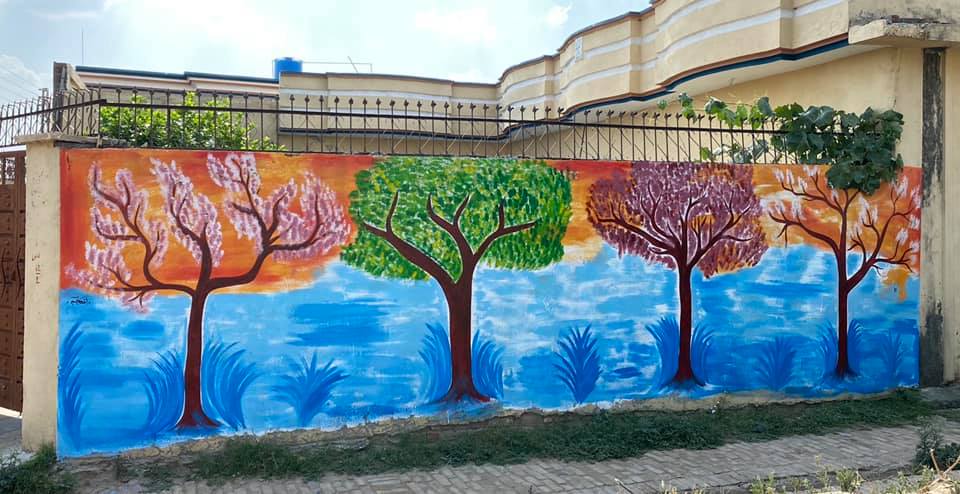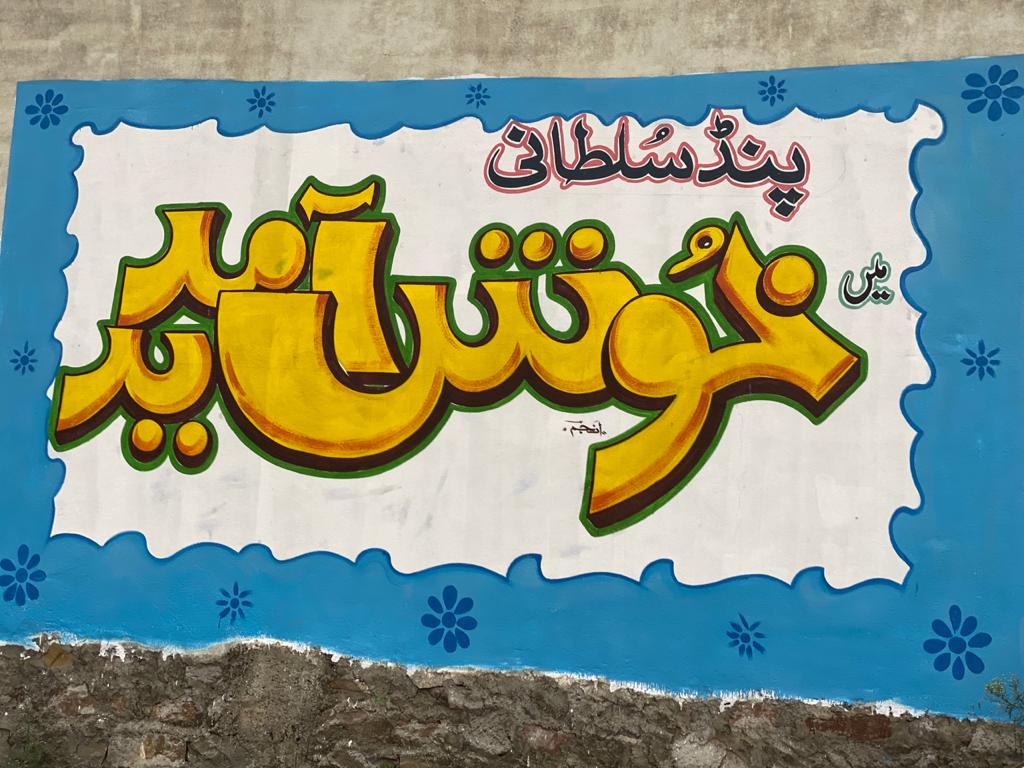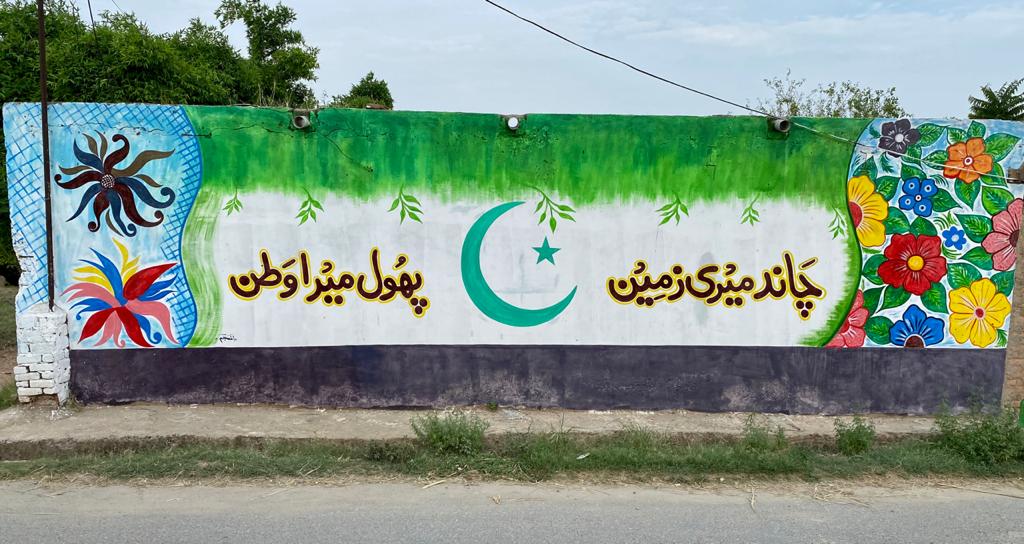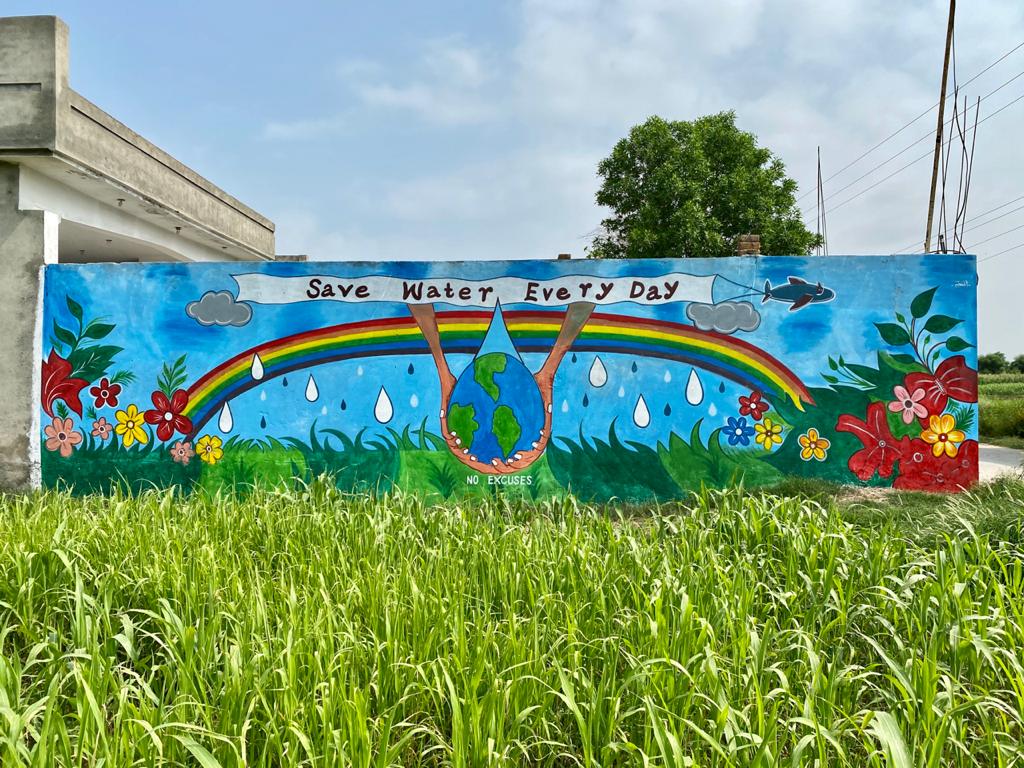 11. “PAKISTAN ZINDABAD”
11. “PAKISTAN ZINDABAD”
Love for Pakistan and love for nationhood can be visualized in the contemporary wall moral. Representation of all four provinces can be seen in the wall art. Minar-e-Pakistan as the identity of Punjab, Ziyarat residency of the founding father of the nation Mr. Muhammad Ali Jinnah as a symbol of Baluchistan, Khyber Pass the identity of Khyber Pakhtunkhwa, the graveyard of Mr. Muhammad Ali Jinnah as the representation of Sindh province are there in this wall drawing. Faisal mosque of Islamabad completes this eye-catchy symbolic street wall painting as a symbol of the federation. The slogan of “LONG LIVE PAKISTAN” gives the goosebumps along with this painting and encourages the patriotism of the Pakistani nation.
Pakistan Zindabad is a common phrase in Pakistan that means “Long Live Pakistan” or “Pakistan Forever.” It is a patriotic slogan that has been used in the country for many years to express love and devotion for the nation.
Pakistan gained independence on August 14, 1947, after a long and difficult struggle led by Muhammad Ali Jinnah and other prominent leaders. The creation of Pakistan was a momentous occasion that brought joy and happiness to millions of people who had longed for an independent homeland where they could practice their religion and live their lives without fear of persecution.
The phrase “Pakistan Zindabad” became popular soon after the creation of Pakistan. It was used to express pride in the new nation and to show support for its leaders and institutions. It was also used as a rallying cry during political rallies, sports events, and other public gatherings.
Over the years, the phrase “Pakistan Zindabad” has become a symbol of national unity and pride. It is used by people from all walks of life, regardless of their religion, ethnicity, or social status. It is a reminder that despite our differences, we are all united by our love for Pakistan.
The phrase “Pakistan Zindabad” is often heard during national holidays and events, such as Independence Day, Republic Day, and Defence Day. It is also used by the armed forces as a way of showing their dedication to the country and their commitment to protecting its sovereignty and territorial integrity.
However, the phrase “Pakistan Zindabad” has also been used by some individuals and groups to promote extremist and violent ideologies. Some extremist organizations have used the slogan to justify acts of terrorism and violence, which is a gross distortion of its true meaning.
It is important to remember that the phrase “Pakistan Zindabad” is a symbol of unity and patriotism, not a tool for promoting violence or extremism. We should all strive to use it in a positive and constructive manner, to promote peace, harmony, and progress in our beloved nation.
In conclusion, Pakistan Zindabad is more than just a phrase or a slogan; it is a symbol of our love and devotion for our country. It represents the sacrifices and struggles of our ancestors, as well as the hopes and aspirations of future generations. Let us all pledge to use this phrase in a positive and constructive way, to build a better and brighter future for Pakistan.
 12. “PAKISTAN KA MATLAB KYA? LA ILAHA ILLALLAH”
12. “PAKISTAN KA MATLAB KYA? LA ILAHA ILLALLAH”
The ideology of Pakistan is reflecting in the contemporary wall painting. The official name of Pakistan is the Islamic Republic of Pakistan that shows the identity and ideology of the country. The basic ideology of Pakistan is that it would be an Islamic welfare state where all minorities will be treated equally. Also, both, Muslims and non-Muslims will be free to practice their religious beliefs. However, sovereignty and supremacy of Islam will be maintained and unchallengeable. The current wall art is highlighting the same basic ideology of Pakistan that it is a Muslim state that respects all the religions, however, will not compromise on the Islamic ideology.
Pakistan ka matlab kya? La ilaha illallah is a famous slogan in Pakistan that translates to “What is the meaning of Pakistan? There is no God but Allah.” This phrase highlights the Islamic roots of the country and the importance of the Islamic faith in the lives of its people.
Pakistan was founded in 1947 as a homeland for Muslims in South Asia. Its founding father, Muhammad Ali Jinnah, envisioned a state that would uphold Islamic principles and provide a safe haven for Muslims who were facing persecution in India.
The slogan “Pakistan ka matlab kya? La ilaha illallah” is a reminder of the founding principles of the country and its Islamic identity. It emphasizes the belief in the oneness of Allah and the importance of faith in the lives of Pakistanis.
The phrase is often used in political speeches, religious gatherings, and national events. It is a powerful symbol of national unity and serves as a unifying force for the diverse communities that make up Pakistan.
However, the slogan has also been misused by some extremist groups to justify acts of violence and terrorism in the name of Islam. This is a misinterpretation of the true meaning of the phrase, which emphasizes the peaceful nature of Islam and the importance of tolerance and respect for all people.
It is important to remember that Pakistan is a country that is built on the principles of Islam, but it is also a nation that is home to people from diverse backgrounds and religions. The slogan “Pakistan ka matlab kya? La ilaha illallah” should be seen as a call for unity and respect for all, rather than a tool for promoting extremist ideologies.
In conclusion, “Pakistan ka matlab kya? La ilaha illallah” is a powerful phrase that represents the Islamic identity of Pakistan and its people. It is a reminder of the founding principles of the country and the importance of faith in the lives of its citizens. However, it is important to use this phrase in a positive and inclusive manner, to promote peace and harmony in Pakistan and the world.
 13. “SAVE ENERGY, SAVE MONEY, SAVE THE PLANET”
13. “SAVE ENERGY, SAVE MONEY, SAVE THE PLANET”
Unnecessary use of anything can be harmful in all means. In a country like Pakistan, where energy is a very critical issue to resolve, we need to be careful with energy consumption to secure it for our near future. In the current wall mural, the message of careful use of energy is the main subject. With beautiful masterstrokes, the well-known painter of the neighboring village of Pindsultani, Mr. Fiaz Anjum gives us a detailed message regarding energy saving. It is also described that through saving energy how it will be beneficial for saving nature by less harming nature. Similarly, it will be much economical for us to save our energy resources along with natural resources, as well as financial resources.
The phrase “Save Energy, Save Money, Save the Planet” has become a common mantra in recent years as people become more aware of the need to conserve natural resources and reduce their impact on the environment. This phrase highlights the interconnectedness of our actions and the consequences they have on both our finances and the health of our planet.
Saving energy is an essential part of reducing our carbon footprint and combating climate change. By using energy-efficient appliances, turning off lights when leaving a room, and reducing our reliance on fossil fuels, we can significantly reduce the amount of greenhouse gases that are released into the atmosphere.
In addition to helping the environment, saving energy can also save us money. By using less energy, we can reduce our utility bills and keep more money in our pockets. Small changes like turning off appliances when not in use and using a programmable thermostat can make a big difference in our energy bills.
Saving the planet is the ultimate goal of our energy conservation efforts. The effects of climate change are becoming more and more evident, from rising sea levels to more frequent and severe natural disasters. By reducing our carbon footprint and conserving natural resources, we can help slow down the pace of climate change and preserve the planet for future generations.
Saving energy and money can also lead to other benefits, such as improving the quality of our air and water. By reducing our use of fossil fuels, we can improve air quality and reduce the risk of respiratory illnesses. By conserving water, we can ensure that we have enough clean water for drinking and other essential needs.
In conclusion, the phrase “Save Energy, Save Money, Save the Planet” highlights the importance of our actions in shaping the health of our planet and our finances. By taking small steps to conserve energy and reduce our carbon footprint, we can make a big difference in the world around us. Let us all commit to making energy conservation a priority and work together to build a sustainable future for ourselves and generations to come.
 14. “FOUR WEATHERS”
14. “FOUR WEATHERS”
Pakistan is one of the exceptional gifts by the Almighty that is blessed with incomparable natural beauty and unlimited blessings. Pakistan is blessed with four unique kinds of weather like; Summer, winter, autumn, and spring seasons. This sort of weather combination can rarely be witnessed. In the contemporary wall mural, four kinds of weather in Pakistan can be seen. With beautiful oil painting, the beauty of each weather season is marvelously described with the entire charm of each season.
As we go about our daily lives, we often take the weather for granted. We might complain about the rain or the heat, but we rarely stop to appreciate the beauty and diversity of the weather around us. In fact, there are many different types of weather, each with its own unique characteristics and impacts on our lives. In this article, we’ll take a closer look at four distinct weather patterns that are common across the globe: sunny, rainy, windy, and snowy.
- Sunny Weather
Perhaps the most beloved weather of all, sunny weather is characterized by clear skies, bright sunshine, and warm temperatures. This type of weather is most commonly associated with summer and tropical climates, but can also occur in other seasons and regions. Sunny weather is often viewed as a symbol of happiness and positivity, and can boost our mood and energy levels.
However, it’s important to remember that too much sun exposure can be harmful to our health. Sunburn, heat exhaustion, and skin cancer are all risks associated with excessive exposure to UV rays. It’s important to protect ourselves with sunscreen, hats, and other protective clothing, and to stay hydrated when out in the sun.
- Rainy Weather
Rainy weather is often associated with gloom and sadness, but it can also be beautiful and refreshing. Rain occurs when water vapor in the air condenses into droplets, which fall to the ground as precipitation. Rain can be light or heavy, and can last for minutes or days.
While rain is essential for plant growth and maintaining our planet’s ecosystems, it can also cause flooding and other types of damage. In areas with poor drainage, heavy rain can lead to landslides and mudslides, and can even cause buildings to collapse. It’s important to be prepared for rainy weather by keeping emergency supplies on hand, and by avoiding flood-prone areas during storms.
- Windy Weather
Windy weather can be both exhilarating and frightening. Strong winds can knock down trees and power lines, damage buildings, and make driving hazardous. However, wind can also be harnessed as a renewable energy source, and can provide power to homes and businesses.
In addition to its practical uses, wind can also have a profound effect on our emotions and sense of well-being. The sound of wind blowing through trees or across open fields can be soothing and calming, while gusts of wind can make us feel energized and alive.
- Snowy Weather
Snowy weather is perhaps the most iconic type of weather associated with winter. Snowflakes are formed when water vapor in the air freezes into ice crystals, which then join together to form snowflakes. Snow can be light and fluffy, or heavy and wet, and can accumulate quickly during snowstorms.
While snow can be beautiful and fun to play in, it can also be dangerous. Slippery roads and sidewalks can lead to accidents, and heavy snow can cause roofs to collapse under the weight. It’s important to take precautions during snowy weather, such as wearing appropriate footwear and clothing, and clearing snow from sidewalks and driveways.
In conclusion, the weather is a fascinating and complex phenomenon that has a significant impact on our daily lives. By understanding the different types of weather, we can better prepare ourselves for whatever conditions come our way. Whether it’s sunny, rainy, windy, or snowy, each type of weather has its own unique beauty and challenges that we can learn to appreciate and overcome.
 15. “APNI ABAADIYON SY MUHABBAT, HUBUL WATNI KI TARAF PEHLA QADAM HAI”
15. “APNI ABAADIYON SY MUHABBAT, HUBUL WATNI KI TARAF PEHLA QADAM HAI”
This beautiful street art has a lovely and deep message of love and togetherness. With the attractive strokes of oil paint in this wall mural, Fiaz, the guy who made this beautiful wall drawing, has dramatically portrayed the presence of five provinces of Pakistan. Punjab, KPK, Sindh, Baluchistan and Gilgit Baltistan can be witnessed in five beautiful flowers. The green color is also highlighting the importance of tree plantation. Also, the presence of Pakistani flag color is there therefore, the entire wall mural is emphasizing nationhood and unity.
Apni abadiyon sy muhabbat, hubul watni ki taraf pehla qadam hai, which translates to “loving one’s own population is the first step towards patriotism,” is a powerful sentiment that encapsulates the essence of nationalism. It highlights the importance of valuing and cherishing the people who make up our society, as they are the foundation of our nation.
At the heart of this sentiment is the idea that a strong sense of community and belonging is essential to building a strong and cohesive nation. When we love and care for our fellow citizens, we create a sense of unity and solidarity that transcends our differences and strengthens our bond as a people.
This love and care can take many forms. It can be as simple as showing kindness and compassion to those around us, or as complex as working to address the social, economic, and political challenges facing our communities. It can also involve embracing and celebrating our cultural and linguistic diversity, recognizing that these differences are a source of strength and vitality for our nation.
However, this sentiment is not just about loving and caring for those within our own borders. It also involves recognizing and valuing the contributions of the broader global community, and working towards a more just and equitable world for all. It means extending our compassion and care to those beyond our borders, and recognizing that we are all interconnected and interdependent in our shared humanity.
At its core, apni abadiyon sy muhabbat, hubul watni ki taraf pehla qadam hai, is about recognizing the power and potential of our collective strength as a nation. It is about valuing and cherishing the people who make up our society, and working towards a brighter future for all. It is about embracing our shared humanity and recognizing that we are all in this together.
In a world that often seems divided and fragmented, this sentiment offers a powerful reminder of the importance of community and connection. It challenges us to look beyond our differences and see the humanity in each other, and to work towards a more just and equitable world for all. By loving and caring for our fellow citizens, we take the first step towards building a better, more united, and more peaceful world for generations to come.
 16. “DARAKHAT LAGAIN, UMEED JAGAIN”
16. “DARAKHAT LAGAIN, UMEED JAGAIN”
The plantation is the gesture of a trusting future that allows us to secure our future generations through planting trees. “The true meaning of life is to plant trees, under whose shade you do not expect to sit” (Nelson Henderson). In the current wall painting, the message for public awareness regarding tree plantation can be witnessed. The painting is emphasizing constructing better life for others through a green and clean environment by planting trees. “He that plants trees love others besides himself”, (Thomas Fuller).
The greatest gift one can ever give to the future generation is none other than to plant a tree that will secure the environment. As somebody said; “save today for tomorrow”.
“Darakhat Lagain, Umeed Jagain” is a phrase that carries a lot of weight and significance, especially in the context of environmental conservation and sustainable development. The phrase can be loosely translated to mean “Plant trees, awaken hope”, and it highlights the crucial role that trees play in promoting a sustainable future for our planet.
The world is facing numerous environmental challenges, from climate change to deforestation, which threaten the health and well-being of people and ecosystems alike. These challenges have highlighted the need for urgent action to mitigate their impact and prevent further damage. One of the most effective ways to do this is by planting trees, which have the ability to absorb carbon dioxide from the atmosphere and provide numerous benefits to the environment and communities.
When we plant trees, we not only contribute to mitigating climate change by removing carbon from the atmosphere but also promote biodiversity, prevent soil erosion, and improve air and water quality. Trees also provide food, fuel, and other essential resources for communities, and can contribute to economic development through sustainable forestry practices and ecotourism.
In addition to the environmental benefits, planting trees can also have a profound impact on our collective well-being. Trees are known to have a calming effect on people, and studies have shown that exposure to green spaces can improve mental health and reduce stress levels. Planting trees can also bring communities together, fostering a sense of collective action and responsibility towards the environment and each other.
The phrase “Darakhat Lagain, Umeed Jagain” highlights the importance of taking action towards a sustainable future and acknowledges the power of individual actions to bring about positive change. By planting trees, we can awaken hope for a better future, not only for ourselves but also for future generations.
However, it is essential to recognize that planting trees alone is not enough to address the complex environmental challenges we face. It is crucial to adopt a holistic approach to sustainable development, which includes reducing greenhouse gas emissions, conserving biodiversity, promoting sustainable land use practices, and adopting circular economic models. Such an approach requires concerted efforts from governments, businesses, communities, and individuals alike.
In conclusion, the phrase “Darakhat Lagain, Umeed Jagain” is a powerful reminder of the critical role that trees play in promoting a sustainable future for our planet. By planting trees, we can contribute to mitigating climate change, promoting biodiversity, and improving our collective well-being. However, it is essential to adopt a holistic approach to sustainable development and work together towards a common goal of creating a better world for ourselves and future generations.

 17. “WELCOME TO PINDSULTANI”
17. “WELCOME TO PINDSULTANI”
The wall mural having a friendly and warm note that reflects the great hospitality and cheerful gesture of people of Pindsultani village. Pidsultani is also known as a model village because of its’ satisfactory educational standard, improved health system, and openness of common people. Also, a combination of desi rural and urban lifestyle makes it more glorify and unique than other villages.
 18. “PAKISTAN NOOR HAI, NOOR KO ZAWAL NHI”
18. “PAKISTAN NOOR HAI, NOOR KO ZAWAL NHI”
In this mind refreshing wall mural, there are several messages in a single frame. The great Badshahi Mosque that was built in 1673 is fantastically portrayed in the current magical street wall art. Similarly, there is a beautiful quote of the great Urdu writer, Mr. Wasif Ali Wasif as; “Pakistan Noor Hai, Noor Ko Zawal Nahi”. This beautiful quote expresses his love and affection towards Pakistan. Furthermore, in this wall drawing, a beautiful scene of moonlight in the dark night can be witnessed in this wall painting that can definitely mesmerize anybody with his beauty.
Pakistan, which has a rich history and culture, has faced countless challenges and setbacks over the years. “Pakistan Noor hai oir noor ko zawal nahi” this phrase has become very popular. The people of Pakistan have a shaky faith in their homeland’s potential and future.
Pakistan is Noor means this Pakistan is light. It is a metaphor for the potential of the country and the positive attributes of its people. The people of this country have always been known for their resilience and determination, no matter how thorny their paths may be. Another example of this sentence is that Noor ko Zawal nahi it means that this light cannot be extinguished. This sentence is also written on the walls of Pind sultani village which expresses the commitment to love one’s country.
Pakistan has a rich cultural heritage spanning centuries. Pakistan boasts of unparalleled natural beauty and diversity. Pakistan is a country with a bright future ahead of it and its people are determined to make it a success story. In the same way, on the walls of this village, Pakistan is the light and the phrase “Noor does not fade” is written, which is the phrase of Wasif Ali Wasif. He wrote many articles on it.
 19. “CHAAND MERI ZAMEEN, PHOOL MERA WATAN”
19. “CHAAND MERI ZAMEEN, PHOOL MERA WATAN”
Pakistan is the land of multiculturalism and multi-ethnicity. In this beautiful oil wall painting, representation of different cultures can be witnessed through the representation of different flowers along with the flag of Pakistan. For expressing love with the beautiful homeland, the painter Fiaz Anjum also painted the famous national song of Pakistan in this eye-catchy wall art.
 20. “SAVE WATER EVERYDAY”
20. “SAVE WATER EVERYDAY”
In everyday life, we utilize gallons of water in a limitless amount that reflects our level of dependency on the water other than any natural resource. In contemporary wall mural, the importance of water other than any natural resource, been highlighted by the guy Fiaz, the wall painter that belongs from the neighboring village of Pindsultani.
Water is a precious resource that we often take for granted. Water is useful in daily life for example for drinking, washing, cooking and cleaning. With the world’s rapid growth and ever-increasing demand for water, conservation of this vital resource is essential. In order to increase the value of this blessing and to avoid its wasteful use, people have been given awareness through wall painting on the walls of Pind Sultani village to save water from being wasted.
Following are some ways to use water in daily life.
Fix leaks and drips.
Turn off faucets while brushing your teeth. Instead of running the faucet continuously, use a small container of water.
Do not use a cleaning pipe or faucet in outdoor areas, but pour water in a bucket so that the water does not go waste.
Water the plants early in the morning or in the evening to avoid water loss due to evaporation. Water your plants as needed and avoid overwatering.
Use a dishwasher and washing machine efficiently: Use the dishwasher and washing machine only when they are fully loaded. This will not only save water but also save energy and reduce your utility bills.